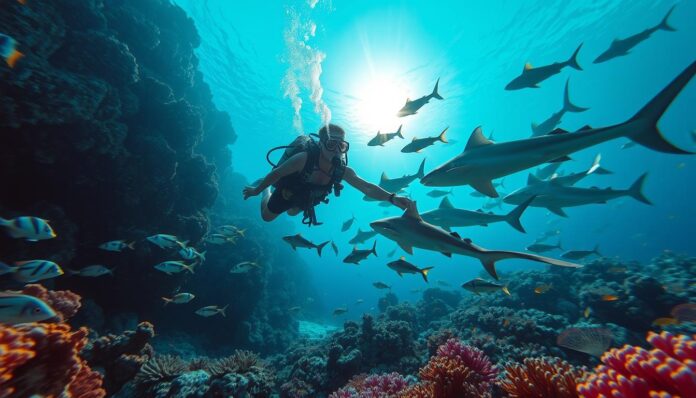Did you know that reef sharks are usually not a threat to humans? Only 5-10 incidents happen each year worldwide. Scuba diving with reef sharks is an amazing way to see the ocean up close. It changes how you see these marine animals.
Blacktip reef sharks are small, about 5 feet long and 30 pounds. They are some of the most interesting creatures in warm seas. Diving with them lets you see marine life in a new way. It turns fear into respect and awe.
Scuba diving with reef sharks is more than just an adventure. It’s a journey into the heart of the ocean. This guide will help you have safe and respectful shark encounters. It’s perfect for both experienced divers and those new to diving.
Key Takeaways – Diving with Reef Sharks
- Reef sharks are generally not dangerous to humans
- Underwater exploration offers unique wildlife interactions
- Proper training is key for safe shark diving
- Different shark species have unique behaviors
- Conservation awareness is vital during marine encounters
Introduction to Reef Sharks
Reef sharks are among the most interesting sea creatures. They are key to keeping coral reefs healthy. By learning about their behavior, divers can see them in a new light.
In the Caribbean, you can find many shark species. Their graceful swimming and hunting ways are amazing. This makes exploring the sea even more exciting.
What are Reef Sharks?
Reef sharks live in warm waters around coral reefs. They are important for keeping the ocean in balance. They help control fish numbers and keep reefs healthy.
- Typically range between 1.6 to 1.8 meters in length
- Highly adapted to shallow reef environments
- Play a critical role in marine ecosystem management
Types of Reef Sharks You Might Encounter
When diving, you might see different reef shark species:
- White Tip Reef Sharks (Triaenodon obesus)
- Inquisitive and dominant species
- Length up to 1.6 meters
- Black Tip Reef Sharks (Carcharhinus melanopterus)
- Typically more timid
- Length up to 1.8 meters
“Sharks are not mindless killing machines, but sophisticated predators critical to ocean ecosystems.” – Marine Biologist
Learning about shark behavior helps divers respect these sea creatures. Each shark has its own special traits. This makes underwater meetings truly unforgettable.
Preparing for Your Scuba Diving Adventure
Going on a scuba diving trip needs careful planning. Whether you’re exploring new places or looking for shark encounters, knowing safety rules is key. This ensures a fun and safe dive.
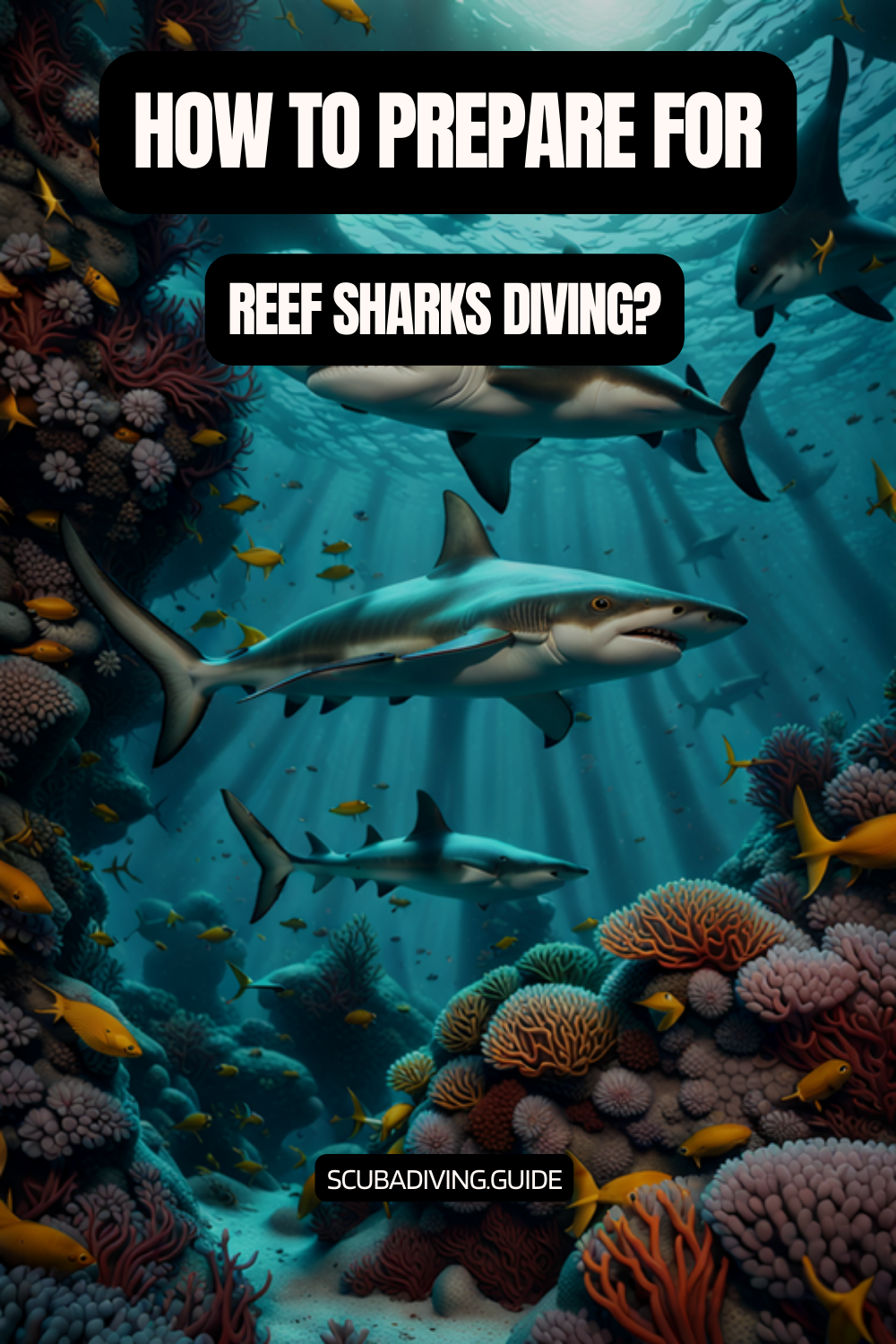
Choosing the right dive spot is important. It can make your dive great or not so good. The best spot depends on several things:
Choosing the Right Dive Location
- Water temperature and visibility
- Shark population density
- Seasonal migration patterns
- Local marine ecosystem health
Essential Gear for Scuba Diving
Having the right gear is vital underwater. Here’s what you need:
| Gear Item | Purpose | Recommended Specification |
|---|---|---|
| Wetsuit | Thermal protection | 5-7mm thickness depending on water temperature |
| Mask | Clear underwater vision | Tempered glass, comfortable fit |
| Regulator | Breathing apparatus | High-quality, regularly serviced |
| Buoyancy Compensator Device (BCD) | Depth and position control | Proper size, good weight distribution |
Health and Safety Considerations
Your safety is the first thing to think about. Important safety steps include:
- Complete professional diving certification
- Undergo medical fitness assessment
- Practice emergency underwater procedures
- Purchase dive insurance
“Preparation is the key to transforming risk into an amazing underwater experience.” – Professional Diving Instructor
Responsible diving means keeping yourself safe and protecting the ocean. Dive wisely, stay informed, and make memories while caring for the sea.
Best Locations for Scuba Diving with Reef Sharks
Exploring the world’s most incredible shark encounters requires knowing the top diving destinations. The planet offers remarkable opportunities for divers seeking unforgettable marine experiences with reef sharks.
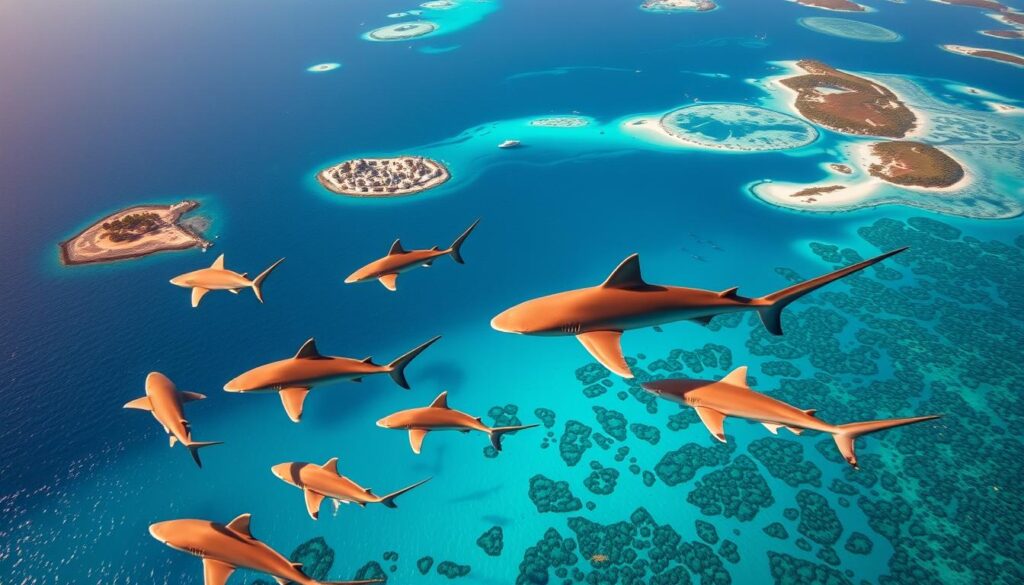
Shark diving enthusiasts have multiple incredible locations to choose from. Each offers unique marine experiences and shark species interactions.
Top Global Diving Destinations for Shark Encounters
Asia:
- Maldives: The Maldives archipelago is renowned for its abundant marine life, including various species of reef sharks. Diving sites such as Fotteyo Kandu and Maaya Thila offer opportunities to encounter grey reef sharks, whitetip reef sharks, and occasionally the elusive leopard shark.
- Palau: Located in the western Pacific Ocean, Palau boasts a rich marine ecosystem and is known for its shark populations. Sites like Blue Corner and German Channel offer thrilling encounters with grey reef sharks, whitetip reef sharks, and the occasional sighting of hammerhead sharks.
- South Africa: Aliwal Shoal, located off the coast of South Africa, is famous for its shark encounters. Divers can experience the thrill of diving with ragged-tooth sharks (sand tiger sharks), also known as “raggies,” as well as other reef shark species like blacktip sharks and Zambezi (bull) sharks.
- Egypt: The Red Sea in Egypt is home to a wide variety of shark species. Popular dive sites such as Brothers Islands, Daedalus Reef, and Elphinstone Reef offer opportunities to encounter species including oceanic whitetip sharks, grey reef sharks, and even the elusive thresher sharks.
Caribbean:
- The Bahamas: The crystal-clear waters of the Bahamas are a haven for shark enthusiasts. Tiger Beach is renowned for its encounters with tiger sharks, lemon sharks, and Caribbean reef sharks. Bimini, located in the western Bahamas, is another hotspot for encounters with reef sharks.
- Belize: The Belize Barrier Reef, a UNESCO World Heritage Site, is teeming with marine life, including various species of sharks. Divers can explore sites like the Great Blue Hole and Glover’s Reef Atoll to encounter Caribbean reef sharks, nurse sharks, and occasionally hammerhead sharks.
- Costa Rica: Cocos Island, located off the coast of Costa Rica, is renowned for its pelagic encounters, including numerous species of sharks. Divers can experience the thrill of diving with hammerhead sharks, Galapagos sharks, and silky sharks in these pristine waters.
- Honduras: The Bay Islands of Honduras, particularly the island of Utila, offer excellent opportunities for encounters with Caribbean reef sharks. Divers can explore sites like Black Hills and Halliburton Wreck to observe these majestic creatures in their natural habitat.
- Azores, Portugal: The Azores archipelago in the North Atlantic is known for its encounters with a variety of shark species. Divers can experience the thrill of diving with blue sharks, mako sharks, and even the occasional sighting of the elusive great white shark.
- Fiji: Fiji’s vibrant coral reefs are home to a diverse array of marine life, including several species of sharks. The Shark Reef Marine Reserve near Beqa Island offers unique opportunities to dive with bull sharks, whitetip reef sharks, and blacktip reef sharks.
- Mexico: The Yucatan Peninsula in Mexico is home to the famous cenotes, unique sinkholes that provide access to a vast underground river system. Divers can explore these cenotes and encounter Caribbean reef sharks, particularly in sites like Cenote Dos Ojos and Cenote Chac Mool.
- Hawaii, USA: The waters surrounding the Hawaiian Islands are home to various shark species. Sites like Molokini Crater and the North Shore of Oahu offer opportunities to dive with whitetip reef sharks, blacktip reef sharks, and the occasional sighting of tiger sharks.
- Galapagos Islands, Ecuador: The Galapagos Islands are a renowned diving destination, offering encounters with iconic marine species. Divers can experience the thrill of diving with scalloped hammerhead sharks, Galapagos sharks, and occasionally whale sharks.
- French Polynesia: The waters of French Polynesia, including destinations like Tahiti and Bora Bora, offer encounters with various shark species. Diving enthusiasts can witness the grace of blacktip reef sharks, whitetip reef sharks, and the occasional sighting of lemon sharks.
When planning a dive trip to these destinations, it is essential to consider the best times of year for shark encounters, local diving conditions, and any specific regulations or guidelines in place to ensure responsible shark diving practices. Dive with reputable operators who prioritize safety, conservation, and the well-being of the sharks and their habitats.
Embarking on a diving adventure to these incredible destinations allows divers to immerse themselves in the beauty of the underwater world and create unforgettable memories while encountering these remarkable creatures.
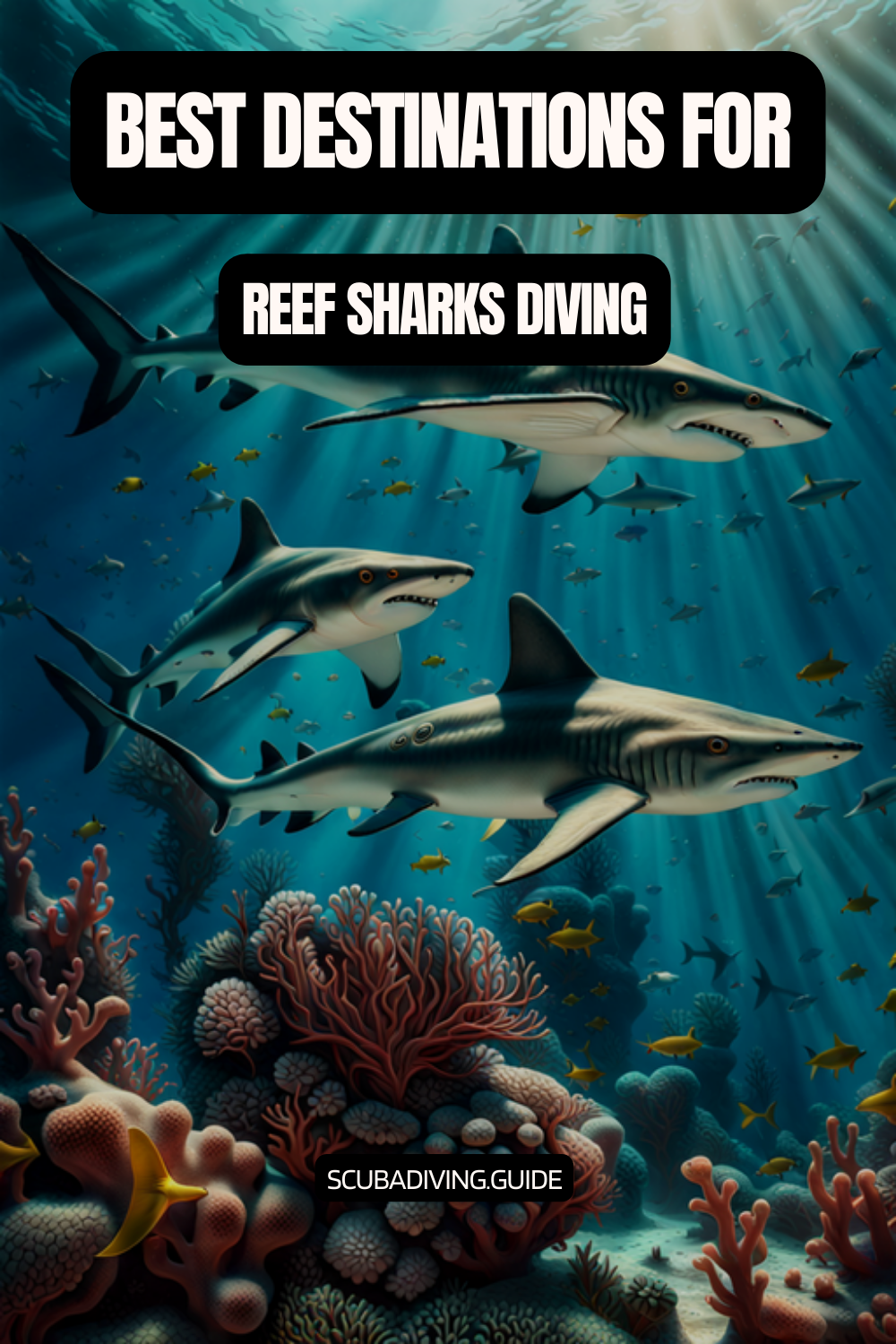
Seasonal Diving Considerations
Timing your shark diving adventure requires careful planning. Different destinations offer optimal shark encounters during specific months.
| Location | Peak Season | Shark Species |
|---|---|---|
| Bahamas | October-January | Tiger Sharks |
| South Africa | June-August | Great White, Sevengill |
| Malapascua, Philippines | December-April | Thresher Sharks |
“The ocean is a vast playground for those willing to explore its magnificent shark inhabitants.” – Marine Biologist
When planning diving destinations, consider water temperature, visibility, and shark migration patterns. Each location offers a unique opportunity for extraordinary shark encounters that will create lifelong memories.
Understanding Shark Behavior
Diving with reef sharks is an exciting underwater adventure. It challenges many myths about shark behavior. These marine predators are more complex than movies show, with fascinating interactions for experienced divers.
Sharks are usually curious, not aggressive. Only about eight people are killed by sharks worldwide each year. This makes underwater meetings safer than many divers think.
How Reef Sharks Interact with Divers
Reef sharks are smart and curious during dives. They often:
- Circle and watch divers from afar
- Approach slowly to check out new things
- Show their territory
Tips for Safe Encounters
It’s important to follow safety rules when meeting reef sharks. Divers should:
- Keep at least 6 feet away from sharks
- Avoid sudden moves that might scare them
- Take off shiny jewelry to avoid attracting sharks
- Stay calm and swim slowly if you meet a shark
“Sharks are more afraid of you than you are of them.” – Marine Biologist Dr. Sylvia Earle
Knowing about shark behavior helps reduce fear and promotes safe marine interactions. With the right knowledge and respect, divers can enjoy these amazing creatures safely in their natural home.
Training and Certification for Divers
Scuba diving with reef sharks needs special training and a professional certification. Divers must learn safety rules to have a fun and safe dive. Getting the right certification makes your shark diving trip amazing.
Professional training gets divers ready for shark encounters. Certification programs teach important skills and build confidence.
Basic Certification Requirements
Before diving with reef sharks, divers need to meet certain requirements:
- Minimum age requirement: 12 years old
- Open Water certification mandatory
- Proof of recent diving experience
- Physical fitness assessment
Advanced Shark Diving Courses
Specialized courses teach more about diving with reef sharks and safety. They cover shark behavior, how to navigate underwater, and conservation.
| Course Details | Specifications |
|---|---|
| Shark Awareness Specialty Course | $324 USD per person |
| Course Duration | 4.5 hours (1:00 PM to 5:30 PM) |
| Dives Included | 2 Shark Dives (1 free swim & 1 shark feeding) |
| Dive Schedule | Monday, Wednesday, Friday & Saturday |
Continuous education is key to mastering advanced diving techniques and understanding marine ecosystems.
“Knowledge transforms fear into respect when diving with marine predators.” – Marine Biology Expert
Optional Training Enhancements
- Nitrox certification
- Underwater photography skills
- Advanced buoyancy control
- Shark behavior interpretation
Proper training ensures safe, responsible, and memorable scuba diving with reef sharks.
Essential Tips for a Successful Dive
Exploring underwater needs careful planning and safety steps. To dive with sharks, you need more than bravery. You also need knowledge, skill, and respect for the sea.
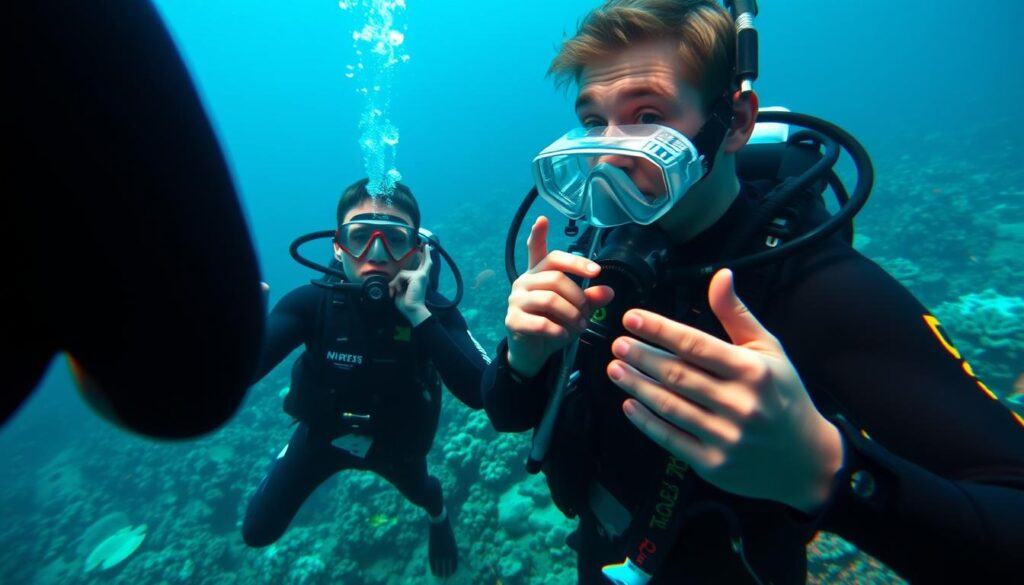
Diving with reef sharks is a big challenge. It requires good preparation and being aware of your surroundings. Professional divers know that success comes from planning well and working together as a team.
Pre-dive Briefing and Site Assessment
A detailed briefing before diving is key to staying safe. Divers should:
- Check the dive site’s conditions
- Learn about marine life habits
- Know the possible environmental issues
- Have clear plans for emergencies
Underwater Communication Strategies
Good communication underwater keeps the team safe and makes diving better. Divers need to:
- Use standard hand signals for shark encounters
- Communicate with their buddy
- Have ways to warn others without speaking
“In the underwater world, communication can mean the difference between an incredible experience and a dangerous encounter.” – Marine Diving Expert
| Communication Method | Purpose | Effectiveness |
|---|---|---|
| Hand Signals | Alert team to shark presence | High |
| Dive Light Signals | Attract attention in low visibility | Medium |
| Proximity Positioning | Maintain group safety | High |
Remember: Sharks are more predictable when divers remain calm and follow established safety protocols.
Photography Tips for Capturing Reef Sharks
Exploring the underwater world is a great chance for photographers to see reef sharks up close. To take amazing pictures of these creatures, you need special skills and the right gear. You also need to know how to take photos underwater.
Best Practices for Underwater Photography
Getting great shark photos takes a lot of planning and skill. Divers need to think about a few key things to get amazing shots:
- Use wide-angle lenses to capture full shark context
- Position strobes carefully to minimize backscatter
- Choose shallow dive depths for optimal lighting
- Avoid wearing shiny or bright objects that might distract sharks
Recommended Camera Equipment
Choosing the right camera and lenses is very important. Experts suggest using the following:
| Camera Type | Recommended Lens | Best For |
|---|---|---|
| DSLR | Fisheye Lens | Close-up shark encounters |
| Mirrorless | Rectilinear Zoom | Wide underwater scenes |
| Compact | Wide-angle Attachment | Beginner marine wildlife photography |
“The key to great shark photography is patience, respect for marine life, and technical preparation.” – Professional Marine Photographer
Places like the Bahamas, Galápagos, and South Africa are perfect for shark photography. With the right gear and skills, you can take stunning photos that show the beauty of reef sharks.
Conservation and Respecting Marine Life
It’s vital to protect marine wildlife to keep our ocean ecosystems healthy. Reef sharks are key in this effort. They help show how well our oceans are doing and how diverse they are.
The situation with shark populations is very concerning. Every year, about 100 million sharks are taken from our oceans. This is a big problem for those trying to save our marine life. Learning how important sharks are can help us protect them better.
Importance of Shark Conservation
Sharks are more than just scary creatures. They are vital for keeping our oceans in balance. Here are some important points:
- There are over 500 shark species in the world.
- Most sharks are not aggressive towards humans.
- Sharks are very important for the health of our oceans.
“We need sharks more than they need us. They are guardians of our marine ecosystems.” – Marine Biologist Research Team
How Divers Can Help Protect Reef Sharks
Divers can play a big role in saving marine wildlife. Here are some ways to help:
- Join in on citizen science projects.
- Support local efforts to protect our oceans.
- Follow safe diving practices.
- Help spread the word about protecting sharks.
By learning about shark behavior and supporting conservation, divers can turn scary encounters into chances to help protect marine life.
Frequently Asked Questions about Reef Shark Diving
Shark encounters can be both thrilling and intimidating for first-time scuba diving enthusiasts. Knowing what to expect during your underwater adventure helps reduce fears. It prepares you for an unforgettable experience.
What to Expect During Your Dive
When you go scuba diving with reef sharks, you’re in for an extraordinary marine encounter. Most shark interactions are calm and controlled. Sharks usually show curiosity, not aggression.
- Sharks will likely observe divers from a distance
- Maintain calm and slow movements underwater
- Expect visual contact within 10-15 meters
- Typical dive duration ranges from 45-60 minutes
Common Myths Debunked
Misconceptions about shark encounters often come from sensationalized media. Scientific data shows fascinating insights about shark behavior:
| Myth | Reality |
|---|---|
| Sharks are aggressive predators | Sharks are typically cautious and non-confrontational |
| All sharks attack humans | Unprovoked shark attacks are extremely rare |
| Sharks actively hunt divers | Sharks are more interested in their natural prey |
“Sharks are far more threatened by humans than we are by them.” – Marine Biologist Dr. Sylvia Earle
Shark diving requires understanding and respect for these magnificent marine creatures. With proper training and guidance, divers can safely enjoy remarkable shark encounters.
Remember, shark sightings depend on various factors like location, season, and marine conditions. Patience and preparation are key to a successful underwater adventure.
Common Marine Species Found Alongside Reef Sharks
Diving with reef sharks provides an opportunity to witness not only these magnificent predators but also a diverse array of marine life that coexists within their habitat. The reefs where sharks reside are teeming with biodiversity, and encountering other species adds to the allure and excitement of the dive. Let’s explore some of the common marine species often found alongside reef sharks.
- Tropical Fish: Vibrant and colorful tropical fish are a common sight in reef environments. Schools of damselfish, butterflyfish, surgeonfish, and angelfish bring the reef to life with their brilliant hues and intricate patterns. These fish often seek refuge and food among the corals, creating a vibrant and dynamic underwater tapestry.
- Eels: Various species of eels inhabit the reef, and their sinuous movements make them fascinating to observe. Moray eels, with their elongated bodies and sharp teeth, often occupy crevices within the reef. They occasionally venture out to feed, showcasing their unique hunting techniques and adding an element of intrigue to the dive.
- Rays: Graceful and majestic, rays are often found gliding over sandy bottoms near the reef. Species such as stingrays and eagle rays captivate divers with their effortless movements and elegant forms. Observing these magnificent creatures in their natural habitat is a remarkable experience that adds a touch of grace to the underwater landscape.
- Turtles: Encounters with turtles are a cherished highlight of diving experiences. These ancient reptiles, such as green turtles and hawksbill turtles, navigate the reef with serene poise. Observing them gracefully swim or seek nourishment among the coral formations evokes a sense of awe and connection to the natural world.
- Crustaceans: The reef ecosystem is home to a diverse range of crustaceans, including shrimp, crabs, and lobsters. Their intricate shapes and fascinating behaviors make them captivating subjects for underwater photography. Searching among the coral heads and crevices, divers may discover these fascinating creatures going about their daily routines.
- Octopuses: Elusive and intelligent, octopuses can be a delight to encounter during reef shark dives. Their ability to change color and shape allows them to blend seamlessly into their surroundings, making them masters of camouflage. Observing their clever hunting techniques or witnessing their interactions with other marine life is a unique experience.
- Snappers and Groupers: Schools of snappers and groupers are often found hovering near the reef, creating a vibrant spectacle of motion and color. These larger fish play important roles in the reef ecosystem, contributing to the balance of predator-prey dynamics. Their presence adds a sense of energy and excitement to the dive.
- Invertebrates: The reef is home to a myriad of invertebrates, including sea anemones, sea stars, and colorful nudibranchs. These fascinating creatures showcase intricate details and patterns, creating a mosaic of life within the coral reefs. Exploring the nooks and crannies of the reef reveals a hidden world of fascinating invertebrate species.
Encountering these common marine species alongside reef sharks offers a holistic view of the interconnectedness of life within the reef ecosystem. Each species contributes to the delicate balance and plays a vital role in maintaining the health and biodiversity of the reef.
As divers venture into the realm of reef sharks, they bear witness to the captivating tapestry of marine life, reaffirming the need for conservation efforts to protect these fragile ecosystems. By appreciating and respecting the diversity of species encountered, divers can contribute to the preservation of the underwater world for future generations to enjoy.
Conclusion: Embrace the Adventure
Diving with reef sharks is an amazing adventure that’s more than just exploring the ocean. It connects us deeply with marine life, changing how we see these incredible predators. Every dive is a chance to see the delicate balance of life under the sea, with sharks playing a key role.
Seeing the underwater world up close makes us understand why we need to protect it. The Red Sea, with its 1,200 fish species and 200 coral species, shows how vital sharks are. They’re not just hunters; they’re vital for the health of our oceans.
Shark diving also changes us in ways we don’t expect. It can boost our self-esteem and reduce stress. Swimming with sharks like Grey Reef and Hammerheads is a life-changing experience. It teaches us about marine life and our own abilities.
Our journey underwater doesn’t stop when we come up to the surface. It’s a lifelong promise to learn, protect, and respect the sea. By diving responsibly and supporting conservation, we join a global effort to save our oceans for the future.
Inspiring Stories from Other Divers
People all over the world have amazing stories of their shark encounters. These tales show how diving can deeply impact us. They remind us to dive with respect, curiosity, and a focus on sustainable tourism.
Encouraging Responsible Diving Practices
Responsible diving is more than just following safety rules. It’s about getting involved in marine conservation and supporting local efforts. It’s also about sharing the importance of sharks in keeping our oceans healthy.
FAQ – Diving with Reef Sharks
Are reef sharks dangerous to divers?
No, reef sharks are not dangerous to divers if approached with respect. They are curious but cautious. Attacks on humans are rare. Dive operators follow strict safety rules for safe shark encounters.
What certifications do I need to dive with reef sharks?
You need an Open Water Diving certification at least. For more shark diving, an Advanced Open Water certification is better. Some places might need more certifications or diving experience.
What’s the best time of year to dive with reef sharks?
The best time varies by location. The Bahamas is great all year. Palau has seasons for the best shark diving. Water temperature and migration patterns are key.
How close can I get to reef sharks during a dive?
Stay 10-15 feet away from sharks, says dive guides. This lets you observe without disturbing them. Divers should move slowly and respect sharks’ space for a safe dive.
What equipment do I need for a reef shark dive?
You’ll need a wetsuit, mask, fins, regulator, and dive computer. Dark-colored wetsuits are recommended for shark diving. Also, bring a dive knife, underwater camera, and safety signals.
How can I contribute to shark conservation during my dive?
Choose responsible dive operators and join citizen science projects. Avoid flash photography and touching marine life. Spread the word about sharks’ importance in the ocean. Many dives focus on conservation.
What should I do if a shark shows too much interest in me?
Stay calm and don’t panic. Slowly move towards your group or guide. Most dive operators teach how to handle shark interactions.
Are some reef shark species more common for diving encounters?
Yes, white tip, black tip, and grey reef sharks are common. Each species has unique behaviors, making them interesting to watch and photograph.
How physically fit do I need to be to dive with reef sharks?
You need a moderate fitness level. Be able to swim well and have good health. Check with your doctor before diving with sharks.
What’s the average cost of a reef shark diving experience?
Prices vary by location, duration, and services. Costs range from $100 to $500 per dive. Multi-day packages are often cheaper.
